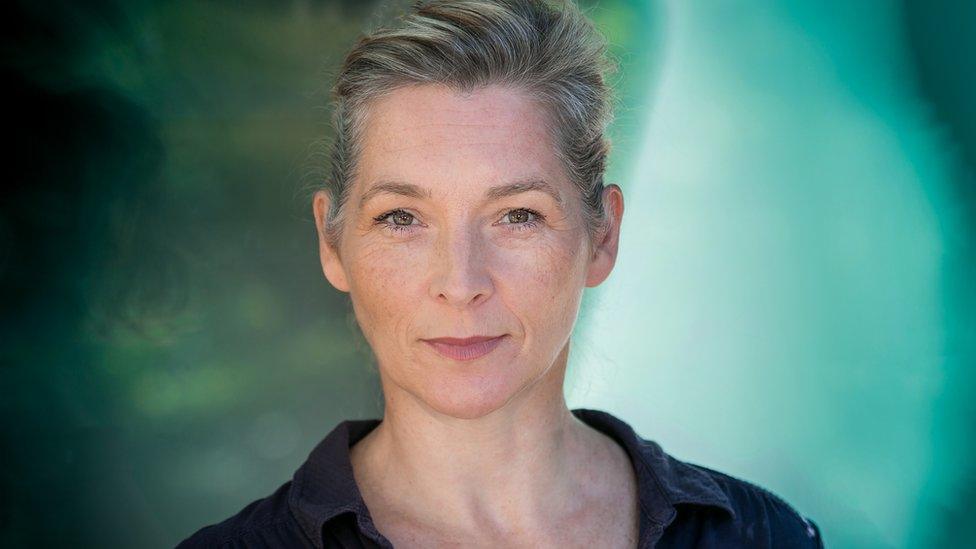I May Destroy You: How Ita O'Brien choreographed TV's most talked-about sex
- Published

Ita O'Brien's background is in dance and acting
I May Destroy You creator Michaela Coel has dedicated her best actress Bafta to the woman who choreographed the sex on the show - describing her work as "essential".
Ita O'Brien was intimacy co-ordinator for the 12-part drama, in which Coel plays a woman trying to remember and come to terms with a sexual assault.
Her work allows actors to "make work about exploitation, loss of respect, about abuse of power, without being exploited or abused in the process," Coel said.
"I know what it's like to shoot without an intimacy director - the messy, embarrassing feeling for the crew, the internal devastation for the actor," she told the audience at the Bafta TV Awards.
Ita spoke to Radio 1 Newsbeat last year about her work on I May Destroy You and other shows including Normal People and Sex Education.
Here's what she told us - with some minor plot spoilers.
I May Destroy You

Michaela Coel and Weruche Opia play best mates Arabella and Terry in I May Destroy You
Some scenes in I May Destroy You are tough to watch, featuring sexual assault and stealthing - when a man removes a condom during sex despite being asked to wear one.
The show focuses on consent, and what happens when it's taken away, and much of the sex is exploitative and abusive.
"Michaela had an absolutely clear idea of what she wanted," says Ita.
"When you have challenging subject matter, what's really important is to make sure the physical nature of the scene is clear and secure."
Once that is in place, the cast members can concentrate on releasing their emotions during the scene, she says.
With a background in dance and acting, Ita became a movement coach in 2007, which then led to her developing a set of intimacy guidelines, external used by all her clients in the TV and film industry.
"As the intimacy co-ordinator, I bring a professional structure and a risk assessment to the content," she says.
In a Bafta Q&A, external, Michaela Coel said Ita brought an "energy that came on set and let us get into our bodies so that we didn't feel weird".
She said having her on set gave everyone "confidence", adding: "Not only is the mental and physical well-being of the cast important, it enables us to get there safely and get what we need for the scene."
Someone else was brought in alongside Ita to help any members of the cast and crew who might need emotional or psychological support after filming the scenes.
"It's not just for the actors," says Ita.
"It's for the entire crew because when you have a challenging subject matter, you don't know who's going to be triggered by that.
"You need to take care across the board."
Normal People
Paul Mescal and Daisy Edgar Jones star in Normal People
In episode two of Normal People, Marianne and Connell have sex for the first time.
The 10-minute scene in Connell's bedroom is full of close-ups of both characters at a crucial point in their relationship.
We're watching Marianne lose her virginity and there's nowhere for the actors - or the audience - to hide.
It was a scene that was praised by viewers for its depiction of consent.
"From the very beginning, I asked Paul Mescal (Connell) and Daisy Edgar Jones (Marianne) what they were OK with in terms of simulated sexual content, nudity and touch."
She wanted to know "what their yes areas were".
"With all my projects, I'm serving the writers' and the directors' vision, so when we get to set I'm watching the conversations between the actors and the director about what's needed."

Ita says one of the biggest shifts in the industry is allowing as much time and space as needed to rehearse intimate scenes.
It's planned out in detail, with the actors involved knowing exactly what will happen and what they're supposed to be doing.
"That means that when you put it in front of the camera, you're going to get the best thing possible."
Sex Education

Ita compares intimacy on screen to a "body dance" and says her role is just like "a choreographer with a dance or a stunt co-ordinator with a fight."
"Just as if you're doing a tango, you've got two bodies moving together in rhythm.
"Or in the case of Sex Education, the important thing is that they weren't in rhythm."
Allow YouTube content?
This article contains content provided by Google YouTube. We ask for your permission before anything is loaded, as they may be using cookies and other technologies. You may want to read Google’s cookie policy, external and privacy policy, external before accepting. To view this content choose ‘accept and continue’.
It brings to mind a scene from the show's season two, as Otis (Asa Butterfield) tries - and fails - to impress Ola (Patricia "Trish" Allison) with his "clock technique".
"Comedy comes from truth," says Ita. "The more truthful something is, the more comedic it is.
"This was the second season so by this point Asa and Trish knew their characters inside out.
"I was on set in fits of giggles, trying to stifle my laughter because what Asa brought to that scene was stunning.
"But that could only happen because everyone had an agreement of touch.
"They're not touching anywhere near the genital areas. We're finding the safe place that looks right and then the movement of the arms sells it completely."
Intimacy director Ita O'Brien talks about shooting sex scenes


Follow Newsbeat on Instagram, external, Facebook, external, Twitter, external and YouTube, external.
Listen to Newsbeat live at 12:45 and 17:45 weekdays - or listen back here.
- Published6 June 2021

- Published26 April 2020

- Published26 May 2019

- Published22 April 2020

- Published11 June 2020

- Published29 January 2020
